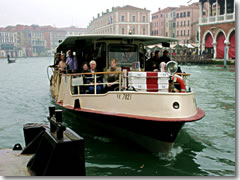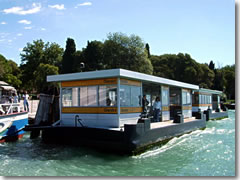- Places
- Plans
- Itineraries
- Experiences

(The name derives from vapore, or "steam," since that is what used to power these public people-movers.)
The back of the map the tourist office hands out has a vaporetto route plan (or you can download a pdf of the 2015 route map here, and I've marked all the major fermate (stops—actually, floating docks) on the ReidsItaly.com Google map of Venice.
 To find a vaporetto office or station in Venice, just look for a sign with the Actv logo: a disc that's green on the top half and blue on the bottom bisected by a white line that looks a bit like a heart monitor reading.
To find a vaporetto office or station in Venice, just look for a sign with the Actv logo: a disc that's green on the top half and blue on the bottom bisected by a white line that looks a bit like a heart monitor reading.
Speaking of heart monitors: Do not flatline when you discover that a single vaporetto ride costs €7 (more on that below).
Welcome to overpriced Venice!
There are three classes of water bus lines:
Getting to St. Mark's
There are three stops for San Marco, so just get off at the first one you reach:
There are many more vaporetto lines, some seasonal, but you are unlikely to need any of them except:

Between midnight and 5am there is are night lines along popular routes (mostly variations on routes from Piazzale Roma down either the Grand Canal or "around the back" via the Giudecca Canal to the San Zaccaria stop at Piazza San Marco, some continuing on to the Lido; there are also runs between Murano and the Fondamente Nove).
These night service vaporetti only run every hour or so, with more frequent departures between the Rialto and Piazzale Roma.
Yes, it is true. Vaporetto tickets really do cost €7. No, the ticket guy is not trying to rip you off; it's the city of Venice that is ripping you off, albeit legally.
It bears repeating: The standard ticket for most lines that putter about central Venice costs a steep €7.
It is valid for 60 minutes, and you can change vaporetti—but only to other boats moving in the same direction as the first boat you boarded (in other words; no round-trips—the expection is the €11 "andata/ritorno" roundtrip ticket to the beach, which is good just on that day between downtown Venice and either the Lido or Punta Sabionetta, or between the Lido and Punta Sabionetta).
You can buy a biglietto (ticket) for the vaporetto either at the ticket kiosks by major vaporetto fermate (docks), or on board the boat (though make sure you seek out the conductor immediately to do so, or you may be assessed a hefty fine).
If you buy the tickets before boarding, make sure you validate it by stamping one end in the little yellow box by the dock (again: fines if you don't).
Unless you're going to use the vaporetti a lot—more than three times in a day, or more than five times over two days—the unlimited-ride biglietto turistico passes aren't really worth it (Venice is very much a walking city), but for the record they come in varying lengths of time:
The only time a pass is really worth it: buy a 24-hour one on the morning you plan to visit the outlying islands, since this usually entails at least five rides.
No, residents of Venice don't have to pay €7 each time they hop the (water)bus. They pay just €1.30 per ride (or €12 for a ten-pack carnet)—and it's valid for 75 min. (rather than 60 min.).
However, they get this reduced fare only if they buy the monthly Venezia Unica tessera (which until recently was called iMob) with the extra CartaVenezia discount enabled.
This card costs local residents €10. You can buy it, too—but it will cost you a whopping €50. (Well, technically €10 plus another €40 to add the Carta Veenzia transport option).
If you truly want one (answer: no), bring your passport and a photocopy of the page with your picture and info to any Hellovenezia office or major ACTV station.
This discount pass is really only be worth it if you're staying in Venice for quite a while (at least a week) and will ride the vaporetto a lot. I mean, a whole lot.
Mathematically, the Venezia Unica/Cartavenezia only starts saving you money starting at your tenth ride (which would cost €70 if you bought individual tickets; the pass plus ten discounted tickets adds up to €62 total)—and that is highly unlikely unless you are commuting.
Last time I was in Venice I stayed for an entire week and rode the vaporetto a grand total of one time—when I first arrived (I took the traghetto to the airport when leaving).
Venice truly is a walking city.
Make sure you board a vaporetto headed in the correct direction.
For example, if you want to head towards downtown Venuce and San Marco along the Grand Canal using lines 1 or 2:
Otherwise you'll end up getting to San Marco the long way around, around the back of the Dorsoduro neighborhood, rather than along the Grand Canal.
The boatmen are used to lost tourists and, at these two hectic stops, will usually assume you want to go down the Grand Canal. Therefore they will try to shoo you away from any boat head in the wrong direction, yelling, "No San Marco! No San Marco!"
Oh, and this might help. Major stops often have two floating docks side by side. Boats headed to your left will dock at the one on the right; boats headed to the right will dock at the one on the left.
I realize this sounds counterintuitive, but from their point of view—and they way they drive—this make perfect sense.
Make sure you head to the correct one, as different lines will dock at different docks.
Share this page
Search ReidsItaly.com